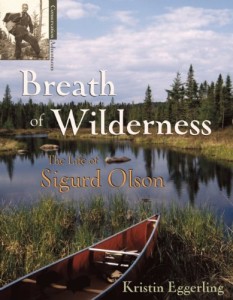By Greg Seitz

While the book is written for young audiences, Eggerling says she never dumbed down his story, and many adults might also appreciate its clarity. According to the author, “This is a story of one man finding his passion and standing up for what he believed even in the face of tremendous adversity.”
Here, she answers a few question about Olson, his life and work, and why she chose him for the subject of her first book.
WN: Do you have a favorite Sigurd Olson anecdote or story from the book?
KE: Sig attended Northland College in Ashland, Wisconsin and was a star player on the football team. One day he realized the weather was perfect for bluebills or greater scaup. Unfortunately, his team was scheduled to play one of their biggest games of the year against Superior State College. Sig chose to skip the game and head into to the woods for the weekend. His team ended up losing. His coach kicked him off and told him to never play football again. He felt guilty, but didn’t regret his choice. I don’t imagine there are many star football players who would do this then or today.
WN: What makes Sigurd Olson unique among other environmentalists of his era?
KE: Sig had such an emotional connection to the outdoors and through his writing he was able to share it with the world. That was and is very powerful. He also had a unique ability to connect with people. When people wrote to him, he wrote back and frequently established long lasting friendships with them. As former Minnesota Governor Elmer L. Andersen once said “Sig conveyed a religious fervor and a depth of conviction that no one else I know succeeded in generating. Others could win adherence. He produced disciples.”
WN: Do you think Olson’s writing and advocacy is still relevant today? How does it fit into the modern world?
Definitely. Many people I meet have read Sig’s writings and continue to feel moved by him. His books have been re-issued, which shows there is still a strong following. His advocacy is also very relevant. Sulfide mining and climate change are serious threats to the BWCA. People don’t spend enough time outdoors, especially children. We need more Sigs to help us deal with these crises.
WN: Why did you write this specifically for children and how did you approach writing for a young audience?
Sig’s story is such an important story for young readers for a number of reasons. Sig’s love for wild places transformed his life. It gave him a purpose that changed the world for the better. He stood up for what he believed in the face of tremendous adversity. His writings were rejected over and over, but he kept at it until he found success. His advocacy for the wilderness made him a pariah in his own town. The outdoors had such a powerful effect on Sig.
I hope that young readers will understand that by reading the book and be more open to venturing outside. Our society will be relying on today’s young people to stand up for wilderness in the future—just as Sig relied on all of us to take over after him. Sig is certainly my hero and I hope that young readers will feel the same.
Writing for children requires boiling down the story and being clear. This is something that many adults also appreciate. I know that I do. I never dumbed down what I wanted to say, but sometimes I had to explain things more.
WN: How did Olson continue, and prevail, despite the significant opposition he faced?
He knew he was right. He had the ability to compromise without selling out. It was more important to him to stand up for and protect the wilderness than be popular. It wasn’t easy, though. He and his wife, Elizabeth, paid dearly for their convictions. How lucky we are that they were willing to make that sacrifice.

